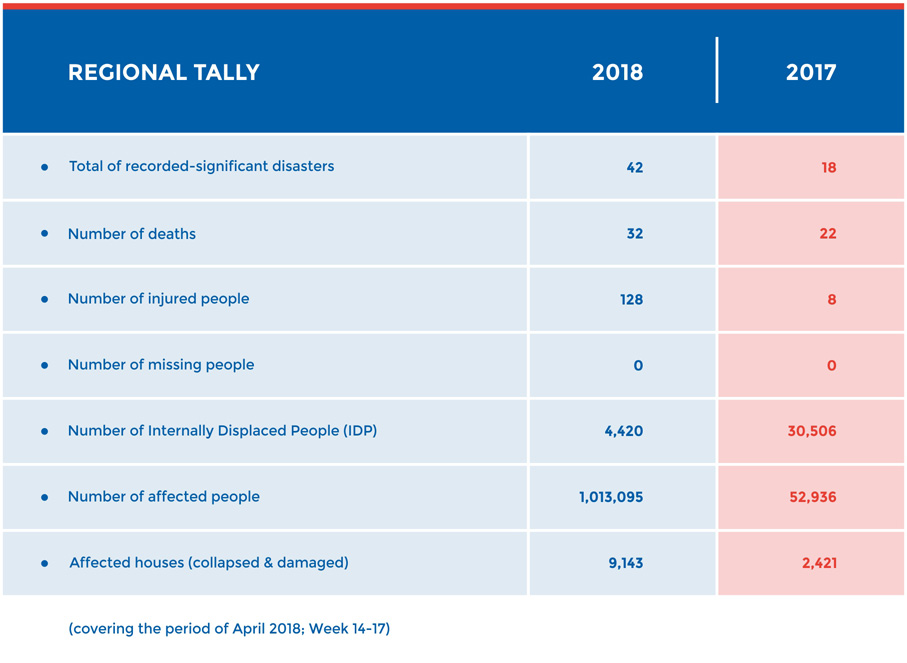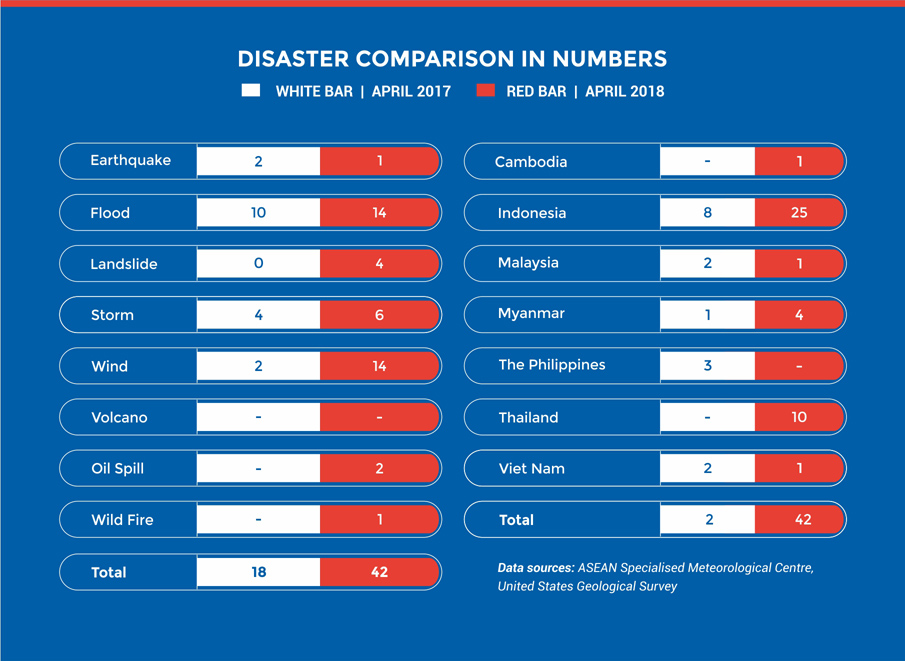
MONTHLY DISASTER REVIEW AND OUTLOOK
APRIL 2018 | DISASTER MONITORING & ANALYSIS
(DMA) UNIT, AHA CENTRE
GENERAL OVERVIEW OF APRIL 2018
Flood and wind-related disasters had by far the highest number of occurrences during April 2018. ASEAN should remain prepared as changes in seasonal and weather patterns occur, increasing the probability and varying impact of hydro-meteorological disasters. According to the ASEAN Specialised Meteorological Centre (ASMC), the northern ASEAN region continued through its traditional dry season, while wetter conditions were experienced in the south of the region, as the monsoon through and its associated rain-band settled close to the Equator. Hailstorms were a notable phenomenon last month in Lao PDR and North-Eastern Thailand, resulting in adverse impacts on power lines, infrastructure and agriculture.
22 moderate-to-strong earthquakes (> M 5.0) were observed across Indonesia, Myanmar and the Philippines during the month, causing minor disruptions locally, but without significant humanitarian impact. One notable event was the M 4.4 earthquake reported in Banjarnegara, Indonesia, with the shallow quake centre and the area’s loose soil conditions causing severe damage to 465 houses (57.8% suffered partial to total collapse).
Technological disasters also took place during April, most notably a range of landfill fires in Myanmar that threatened the health and livelihoods of significant numbers of residents in nearby areas. Significant numbers of people were affected by fumes resulting from these fires, with residents living close to the landfill site experiencing the worst conditions. Starting on the 21st of April, smoke from the fires covered 20 townships across Yangon, with an increased likelihood of adverse health effects – particularly for children and the elderly – experienced by almost 800,000 people within a 30 km radius of the fires.
OUTLOOK FOR MAY-JUNE 2018
The region is expected to gradually transition from the current Northeast Monsoon conditions, to the inter-monsoon conditions in May 2018 – in which low-level winds in the region are generally light and variable in direction, with an increase in shower activities to be expected. Some parts of the northern ASEAN region may continue to experience dry conditions in May 2018, but are likely to ease off with an increase in shower activities as the inter-monsoon period takes hold. For the southern ASEAN region, shower activities are expected over most parts of the area.
For the rest of the April-May-June 2018 season, the northern ASEAN region is likely to experience near-normal rainfall levels, aside from coastal areas of the Andaman Sea and the Philippines, where there is an increased chance of above-normal rainfall. In the southern ASEAN region, slightly below-normal to near-normal rainfall can be expected.
Written by : Mizan Bisri, Qing Yuan Pang
DISCLAIMER
AHA Centre’s estimation is based on data and information shared by National Disaster Management Organisations (NDMOs) and other relevant agencies from ASEAN Member States, international organisations and news agencies. Further information on each recorded-significant disaster, description and details of data and information are available at: http://adinet.ahacentre.org/reports.



